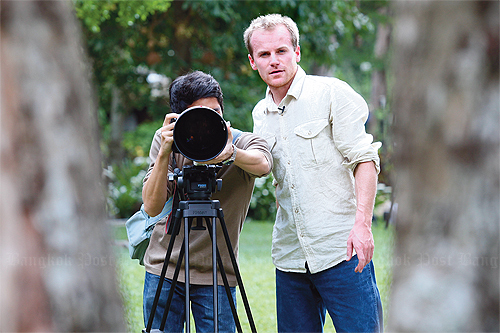'What are you focusing on?" National Geographic photographer Joe Riis asks a teenager taking a picture of a deer at Chon Buri's Khao Kheow Open Zoo. "Usually if I use the big ones [cameras], I'll go down low on the ground like this."

Riis demonstrates his technique. "Try it," he tells the student. "Lay down on your stomach. Just try something different."
The zoo was one of the locations the photographer used for a workshop he held in March and while he's somewhat reserved by nature, Riis assumes an easy confidence as with students. In a world where fashion and celebrity photographers hugely outnumber those capturing wildlife, he's out to even the odds. For Riis doing so is a way to promote the beauty of nature while raising consciousness about wildlife protection.
The son of a wildlife biologist who grew up on a farm on the prairies of South Dakota, one of the least populated states in the US, the 28 year old's career choice was natural in more ways than one. However, he didn't actually start snapping nature photos until he was at the University of Wyoming, where he studied wildlife biology.
Instead of writing journals and filing reports, he recorded his academic journey on film.
After graduation, he started working as a full-time photographer for National Geographic at the age of 23.
Riis' approach to his work is to focus on "the whole story".
While beautiful photographs of animals draw people in, he says it's important that they also reflect the challenges facing the natural world.
"More and more, all over the world, as humans require more resources [the result is] less and less wildlife," he says. "Photography is a common language all over the world, something people can connect to. Sometimes they see one photograph and it changes their minds on a particular issue."
This approach to wildlife photography is something Riis finds lacking. "If there's any conflict between humans and wildlife that photography can help people to be aware of, that's what I think is really important," he says. "Wildlife photography from a journalistic perspective _ not very many people are doing that."

While the majority of his photographs focus on wildlife and scientific research, Riis also respects the work done in other fields, particularly conflict photography.
"I think it [conflict photography] has a lot of power and the people that do it are very committed. They put their lives on the line," he says. "There's also a lot of very important human issues that photojournalists are documenting, and those are stories that we need to see."
Riis says photography has a tremendous potential to spur change.
"People can connect to a photograph and it's pretty incredible how a couple of excellent pictures documenting an issue can change it."
Riis spends the bulk of his time travelling abroad, but he says his most rewarding work to date took place closer to home _ documenting the migration of Wyoming's pronghorn antelopes.
The antelopes have been making the 200km trek _ one of the longest among land mammals _ every autumn from the state's Grand Teton National Park to their winter habitat in the Upper Green River Valley, returning in the spring.
The migration has been taking place for some 6,000 years, but as development has expanded, the antelope now face man-made hurdles, such as fences, roads and housing developments.
Through his work, Riis was able to show people _ including some he grew up with _ the problems the pronghorn face as humans move in.
He says it's easier to highlight areas of concern in one's home country than to do so abroad.
"It's difficult to come into a place when you're a foreigner and you're trying to show something that you think is important. That's very complicated," he says. "The most rewarding experience is probably photographing in your home country. It's important to be passionate about your home and where you're from. If you think something should change, you should speak up, and from my perspective, you should photograph."
Riis says that anyone is capable of learning photography, provided they are curious about the world. He says young snappers should not get bogged down in the mechanics of operating a camera.
"It's more about what you do with it, and that just comes down to how you see the world," he says.
"All photojournalists I know are just very curious about the world and the people in it."
Riis says a career as a photojournalist also requires passion, and more than likely in today's media environment, sacrifice.
"There's less and less money in journalism these days, but all the journalists I know _ they make it work somehow. They don't live in fancy houses," said Riis, adding that many journalists spend most of the money they make on their work.
"It costs a lot to do different stories, but to be honest, money doesn't play that big of a role in what I do and how I live my life. At this point there's really nothing I need to buy. I just need to sustain myself."

